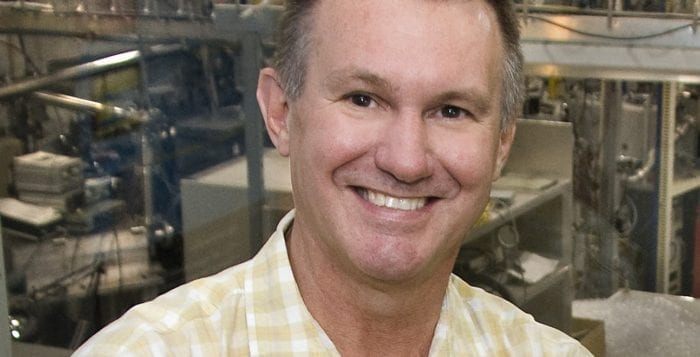Director Robert Ozman leads members of the Harbormen Chorus during a concert at the Unitarian Universalist Fellowship at Stony Brook in E. Setauket on June 27. Photo by Heidi Sutton
By Rita J. Egan
Current and former members of the Harbormen Chorus are warming up for a special luncheon scheduled on Aug. 13 at Lombardi’s on the Sound in Port Jefferson. The North Brookhaven chapter of the Barbershop Harmony Society, well known in the area for its four-part harmony chorus and quartet performances, is celebrating its 50th anniversary and decades of musical memories.
Chapter president Fred Conway is looking forward to the celebration commemorating decades of business in the community. “I don’t think there are a lot of organizations in Brookhaven, especially in North Brookhaven, that have achieved that,” he said.
Conway said on hand for the anniversary luncheon will be Chris Moritz and Ray Gape, the chapter’s first musical director and president, respectively, who in 1965 took out an ad looking for men who were interesting in singing. Also, on hand will be Don Van der Kolk who was a member of the Three Village Four Quartet along with Moritz, Gape and the late Bill MacDevitt.
The organization, which officially became a chapter in 1966 of what was then known as the Society for the Preservation and Encouragement of Barbershop Quartet Singing in America Inc., held its first meeting in 1965. That meeting drew a handful of potential members, and by their first performance in the fall of 1966, there were approximately two dozen men performing. In early 1967, the group had its first annual show.
Since then the Harbormen’s barbershop quartets have performed at the Good Shepherd Hospice Memorial Service, the Port Jefferson Village Dickens Festival, the annual Brookhaven Town Fair, New York Mets and Long Island Ducks baseball games, as well as offered Singing Valentine quartets to serenade local sweethearts.
The chorus, which meets every Monday at the Unitarian Universalist Fellowship in Stony Brook, is open to men of all ages, who are interested in singing a cappella versions of Doo Wop, show tunes, love songs and other old favorites, even if they can’t read music. Conway, who has been a member for 47 years, said his experience with the group is a perfect example of how one doesn’t need to read music.
He was sitting on a crate in his new first house in Rocky Point while watching Super Bowl III when his neighbor knocked on his door and asked if he had seen the announcement in a newspaper. Conway said the ad asked: “Do you like to sing in the shower or in a bar?” “So the two of us went to the chapter meeting, and I stayed there ever since,” Conway said.
He said it took him three years before he could sing in a quartet due to not being a music reader. Since then he has been in nine registered quartets, including his current group Antiquity. Conway, who sings lead, uses a tape recorder to learn. “I form the quartet around myself being a weak link. Those other three guys they all play piano and organ and guitar and they read music, understand music,” he said.
On June 27 the chorus celebrated its first graduating class of “Ready, Set, Sing,” which included 14 men from college to retirement age interested in singing. Conway said the program is a “teaching mechanism.”
“The stipulation was that you have a love of music. You didn’t have to read music or really understand the science involved in it,” Conway said.
Chorus Director Rob Ozman said they don’t turn interested singers away as long as they can carry a tune and like to sing. “It’s nice if someone has a little bit of basic ability, and you just teach them everything they need to know to be able to sing, to work in the chorus,” he said.
The chapter’s director, a music teacher at Mattituck-Cutchogue school district, Ozman started in the chorus in 1980 and in 1981 became music director. He stepped down as director in 1995 to raise his family and was replaced by Antiquity member Gary Wilson as director. He returned a year and a half ago to direct the singers once again.
With over 30 current members as well as former members on hand for the luncheon on Aug. 13, there will be plenty of stories to share. Among Ozman’s favorite memories with the Harbormen is a visit to a local hospital to sing to patients during Christmastime. “There was a young woman who was in a coma and we went into the room, and we were singing for her and she woke up in the middle of the singing. She had been out for quite a while, a number of weeks. And, I’m not saying that we brought her out of it either, we may have just happened to be there at the time, but it’s sure was kind of neat to think well maybe there was just something about it that registered in her brain and woke her up,” Ozman said.
Like Ozman, chapter secretary David Lance, a member for 10 years, has many favorite memories from his years with the chorus. One is a show the group performed in 2012, “Return of the Pirate Chorus.” The chapter secretary said the singers donned pirate costumes while singing parodies such as “Don’t Walk the Gang Plank” to the tune of “Under the Boardwalk.”
He said the Good Shepherd Hospice Memorial Services, where they perform “Irish Blessing” and “I Believe” twice a year, are also special to him. Over the last few years, the Harbormen Chorus has donated part of the proceeds, totaling over $16,000, from their annual show to the health care organization.
“The Good Shepherd Hospice Memorial is the most moving of all because when we sing for them it gives them such encouragement and comfort,” Lance said.
The singer added that anytime the audience responses to the music that “appeals to an older crowd but is not only for them” is a good memory for him. He said they have had many great responses with people singing along, especially at nursing homes. He has witnessed a patient in a wheelchair standing up to direct the chorus and one patient that was practically catatonic perking up upon hearing a song.
Ozman said one of the interesting things about singing in a barbershop quartet for him has been meeting people from all different backgrounds. He said sharing an interest in the four-part harmony genre has brought so many people together.
“You can meet up with people you don’t know, you never sang with them before, but you can sing a song together,” Ozman said.
Among its milestone anniversary activities this year, the chorus will also hold its 50th anniversary annual show at the Unitarian Universalist Fellowship at Stony Brook in Setauket on Oct. 15 at 2 p.m. and 7 p.m. For more information about the Harbormen Chorus and its 50th anniversary party at Lombardi’s on the Sound, call 631-476-6558 or visit www.harbormen.org.














